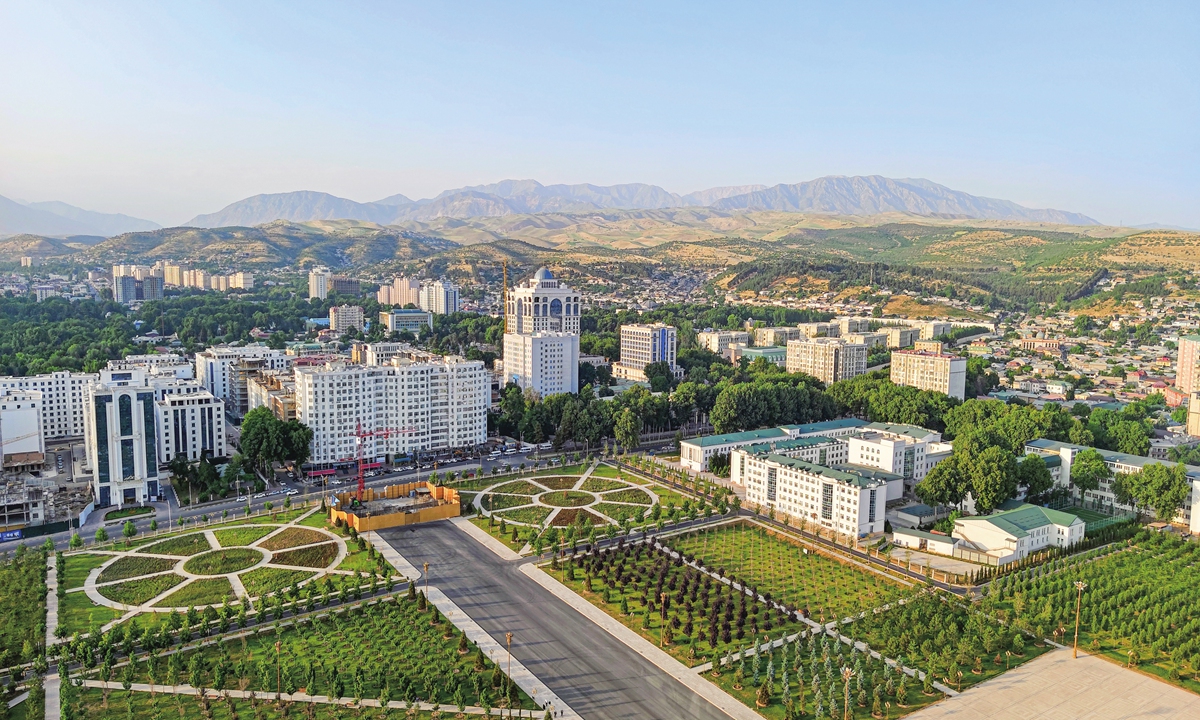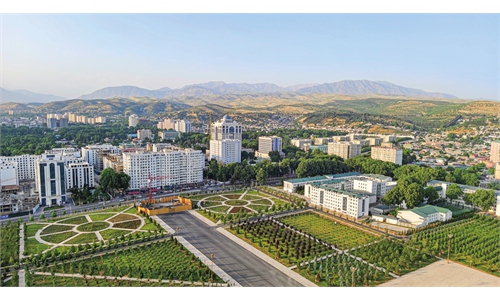Tajikistan to become a ‘connecting bridge’ between China, Central Asia, supporting BRI and cementing regional security: scholar
Tajikistan to expand economic links with China under the BRI: scholar
Editor's Note:
Chinese President Xi Jinping has just wrapped up his state visit to Tajikistan. Tajikistan is one of the earliest countries joining the China-proposed Belt and Road Initiative (BRI), and last year, China and Tajikistan jointly announced the building of a China-Tajikistan Community with a Shared Future featuring everlasting friendship, solidarity and mutual benefit. Last week, Global Times reporters Li Xuanmin and Xing Xiaojing (GT) interviewed Guzel Maitdinova (Maitdinova), a professor at the Department of Foreign Regional Studies and Foreign Policy at Russian-Tajik (Slavonic) University. According to Maitdinova, Tajikistan aims to become a "connecting bridge" between China and Central Asia to facilitate BRI development. She also suggested ramped-up cooperation between the Shanghai Cooperation Organisation (SCO) and Collective Security Treaty Organization (CSTO).

GT: From your perspective, what is your evaluation of current relations between China and Tajikistan?
Maitdinova: The President of Tajikistan Emomali Rahmon paid a state visit to China in May last year, during which the two heads of state jointly announced the building of a China-Tajikistan community with a shared future featuring everlasting friendship, solidarity and mutual benefit.
This means solidarity at the international level and strengthening inter-civilization interaction. This idea also implies that Tajikistan and China have a commonality of interests on current issues, while supporting each other despite civilizational differences. Both China and Tajikistan are countries supporting universal values of cooperation, peace and stability.
The strategic partnership between China and Tajikistan is also based on mutual support of core interests (sovereignty, security and territorial integrity), and on joint efforts to form a development and security partnership, as well as to strengthen and deepen political, trade and economic, and humanitarian cooperation.
Strengthening China-Tajikistan cooperation in this context is important for Tajikistan to increase the level of economic development, develop transportation, energy and communication networks, introduce innovative technologies, deepen cultural ties and exchanges, expand cooperation in the educational sphere, and strengthen cooperation at the interstate level. Also, through such international cooperation, it is important to deepen joint efforts to combat transnational security threats. These areas of cooperation have become priorities in China-Tajikistan relations.
Tajikistan was one of the earliest countries to join the China-proposed Belt and Road Initiative (BRI) and the pairing of the National Development Strategy of Tajikistan for the period up to 2030 (NDS-2030) through the China-proposed BRI.
In 2023 alone, trade turnover between China and Tajikistan reached $3.926 billion, an increase of 53.5 percent year-on-year. It is expected that in 2024, the volume of trade between China and Tajikistan will achieve even greater growth. Meanwhile, it is important for Tajikistan to attract investments in the development of "green economy," as well as transport and logistics links. Tajikistan, which has significant potential in hydropower, can find opportunities for cooperation with China in the development of hydropower projects.
GT: The SCO was established in 2001, with China and Tajikistan being both founding members. In your view, how should China and Tajikistan strengthen cooperation within the SCO framework to maintain regional security and stability?
Maitdinova: SCO has always maintained in its policy that the organization is not a military-political bloc and its function is to maintain stability in its area of responsibility and to counter non-traditional threats and challenges. Within the framework of the SCO, the Regional Anti-Terrorist Structure (RATS) was established to counter the "three evil forces" and other non-traditional threats.
At present, the number of member states in the SCO has been expanding. And accordingly, not only the number of challenges and threats to the organization is growing, but also the measures of responsibility. In these conditions, the SCO has strengthened the interaction among its members to strengthen global security, emphasizing the fight against transnational challenges and threats. And new forms of international coordination are needed to take situational, preventive and strategic actions.
There is also an objective need to strengthen economic and technical cooperation within the SCO, as well as to expand the interaction between the Tajikistan's NDS-2030 strategy, the SCO, the Eurasian Economic Union (EAEU) and the Collective Security Treaty Organization (CSTO) to maintain regional stability and ensure sustainable development. In particular, the cooperation between SCO and CSTO overlaps in many aspects. It is possible to strengthen cooperation between CSTO and SCO on security issues in the region, including ensuring the security of investment projects, and communications infrastructure.

GT: Tajikistan was one of the earliest countries to support the China-proposed BRI. This year marks the 11th year of the BRI's development. How do you view cooperation between the two countries under the BRI, and what achievements have been made?
Maitdinova: Tajikistan views China-proposed BRI as "an opportunity to address the challenge of economic growth." It intends to become a "connecting bridge" between China and other neighboring states in the Central Asia region, as well as to attract additional sources of funding for the implementation of its NDS-2030 in the country's communication and other economic projects.
In August 2016, the China Railway Construction Corporation put into operation a 46-kilometer-long section of the Vahdat-Yavan Railway. The section connected the capital of Dushanbe with Bokhtar and thus facilitated transportation between the enterprises in the country's aluminum industrial complex. This rail line can be considered an integral part of the rail project from China to Afghanistan.
China's assistance is also important for Tajikistan to realize a number of strategic objectives in building communications, constructing energy and other strategic facilities, and building an industrial-agrarian economy. Pairing Tajikistan's NDS-2030 with the BRI will help deepen political mutual trust, expand mutually beneficial cooperation, strengthen connectivity and infrastructure construction, develop digital industrialization and digitization of industry. The synergy can not only promote the modernization of Tajikistan, but also promote the strengthening and deepening of strategic partnership.
In November 2022, the Luban Workshop officially opened in Tajikistan, and was the first of its kind in Central Asia. Currently, the workshop organizes advanced training courses for employees of Tajik enterprises in the sectors of road construction, geodesy and industry, and energy. The workshop contributes to the training of highly qualified specialists, which are necessary for the modernization of Tajikistan and the implementation of the NDS-2030.
Chinese President Xi Jinping has just wrapped up his state visit to Tajikistan. Tajikistan is one of the earliest countries joining the China-proposed Belt and Road Initiative (BRI), and last year, China and Tajikistan jointly announced the building of a China-Tajikistan Community with a Shared Future featuring everlasting friendship, solidarity and mutual benefit. Last week, Global Times reporters Li Xuanmin and Xing Xiaojing (GT) interviewed Guzel Maitdinova (Maitdinova), a professor at the Department of Foreign Regional Studies and Foreign Policy at Russian-Tajik (Slavonic) University. According to Maitdinova, Tajikistan aims to become a "connecting bridge" between China and Central Asia to facilitate BRI development. She also suggested ramped-up cooperation between the Shanghai Cooperation Organisation (SCO) and Collective Security Treaty Organization (CSTO).

Guzel Maitdinova, a professor at the Department of Foreign Regional Studies and Foreign Policy at Russian-Tajik (Slavonic) University Photo: Courtesy of Guzel Maitdinova
GT: From your perspective, what is your evaluation of current relations between China and Tajikistan?
Maitdinova: The President of Tajikistan Emomali Rahmon paid a state visit to China in May last year, during which the two heads of state jointly announced the building of a China-Tajikistan community with a shared future featuring everlasting friendship, solidarity and mutual benefit.
This means solidarity at the international level and strengthening inter-civilization interaction. This idea also implies that Tajikistan and China have a commonality of interests on current issues, while supporting each other despite civilizational differences. Both China and Tajikistan are countries supporting universal values of cooperation, peace and stability.
The strategic partnership between China and Tajikistan is also based on mutual support of core interests (sovereignty, security and territorial integrity), and on joint efforts to form a development and security partnership, as well as to strengthen and deepen political, trade and economic, and humanitarian cooperation.
Strengthening China-Tajikistan cooperation in this context is important for Tajikistan to increase the level of economic development, develop transportation, energy and communication networks, introduce innovative technologies, deepen cultural ties and exchanges, expand cooperation in the educational sphere, and strengthen cooperation at the interstate level. Also, through such international cooperation, it is important to deepen joint efforts to combat transnational security threats. These areas of cooperation have become priorities in China-Tajikistan relations.
Tajikistan was one of the earliest countries to join the China-proposed Belt and Road Initiative (BRI) and the pairing of the National Development Strategy of Tajikistan for the period up to 2030 (NDS-2030) through the China-proposed BRI.
In 2023 alone, trade turnover between China and Tajikistan reached $3.926 billion, an increase of 53.5 percent year-on-year. It is expected that in 2024, the volume of trade between China and Tajikistan will achieve even greater growth. Meanwhile, it is important for Tajikistan to attract investments in the development of "green economy," as well as transport and logistics links. Tajikistan, which has significant potential in hydropower, can find opportunities for cooperation with China in the development of hydropower projects.
GT: The SCO was established in 2001, with China and Tajikistan being both founding members. In your view, how should China and Tajikistan strengthen cooperation within the SCO framework to maintain regional security and stability?
Maitdinova: SCO has always maintained in its policy that the organization is not a military-political bloc and its function is to maintain stability in its area of responsibility and to counter non-traditional threats and challenges. Within the framework of the SCO, the Regional Anti-Terrorist Structure (RATS) was established to counter the "three evil forces" and other non-traditional threats.
At present, the number of member states in the SCO has been expanding. And accordingly, not only the number of challenges and threats to the organization is growing, but also the measures of responsibility. In these conditions, the SCO has strengthened the interaction among its members to strengthen global security, emphasizing the fight against transnational challenges and threats. And new forms of international coordination are needed to take situational, preventive and strategic actions.
There is also an objective need to strengthen economic and technical cooperation within the SCO, as well as to expand the interaction between the Tajikistan's NDS-2030 strategy, the SCO, the Eurasian Economic Union (EAEU) and the Collective Security Treaty Organization (CSTO) to maintain regional stability and ensure sustainable development. In particular, the cooperation between SCO and CSTO overlaps in many aspects. It is possible to strengthen cooperation between CSTO and SCO on security issues in the region, including ensuring the security of investment projects, and communications infrastructure.

A city view of Dushanbe, capital of Tajikistan Photo: VCG
GT: Tajikistan was one of the earliest countries to support the China-proposed BRI. This year marks the 11th year of the BRI's development. How do you view cooperation between the two countries under the BRI, and what achievements have been made?
Maitdinova: Tajikistan views China-proposed BRI as "an opportunity to address the challenge of economic growth." It intends to become a "connecting bridge" between China and other neighboring states in the Central Asia region, as well as to attract additional sources of funding for the implementation of its NDS-2030 in the country's communication and other economic projects.
In August 2016, the China Railway Construction Corporation put into operation a 46-kilometer-long section of the Vahdat-Yavan Railway. The section connected the capital of Dushanbe with Bokhtar and thus facilitated transportation between the enterprises in the country's aluminum industrial complex. This rail line can be considered an integral part of the rail project from China to Afghanistan.
China's assistance is also important for Tajikistan to realize a number of strategic objectives in building communications, constructing energy and other strategic facilities, and building an industrial-agrarian economy. Pairing Tajikistan's NDS-2030 with the BRI will help deepen political mutual trust, expand mutually beneficial cooperation, strengthen connectivity and infrastructure construction, develop digital industrialization and digitization of industry. The synergy can not only promote the modernization of Tajikistan, but also promote the strengthening and deepening of strategic partnership.
In November 2022, the Luban Workshop officially opened in Tajikistan, and was the first of its kind in Central Asia. Currently, the workshop organizes advanced training courses for employees of Tajik enterprises in the sectors of road construction, geodesy and industry, and energy. The workshop contributes to the training of highly qualified specialists, which are necessary for the modernization of Tajikistan and the implementation of the NDS-2030.




